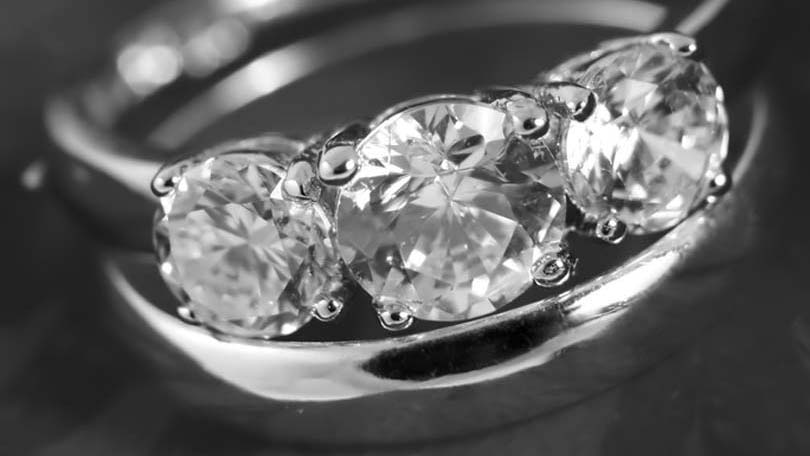
It all began in India.
Somewhere buried deep in the alluvial deposits of the country, diamonds were discovered. At first, they were used as amulets to appease the gods, and hence associated with the concept of divinity; years later, people discovered its usefulness for industrial applications and of course, for making jewelry.
What comes to mind when you hear the word “diamond”? You’ll probably come up with that cliché about diamonds being a girl’s best friend (which is still true, by the way) or you’ll say, “Elizabeth Taylor of course!” Richard Burton sure knew how to win a woman’s heart.
Diamonds weave a fascinating story. If you roll up your sleeves, put on a comfortable pair of old sneakers and sit for hours in the library reading about diamonds, you could get hooked and forget about lunch for a change. There’s a lot more to what the average person knows about this gemstone. Apart from the rich and famous romances tied to diamonds and given much media coverage, diamonds actually have a more mystifying allure when they come out of the earth’s crust, make it to the cutter’s workshop, and then make a long international passage to global markets.
When a beautiful woman walks into a room, elegant in her fur coat and Prada shoes, she’ll catch everyone’s gaze. But when she slowly and gracefully turns her head and tiny glittering lights bounce around as she moves, you’ll know that what she’s got, some people would die for. Her face and figure may be her greatest assets, but her diamonds will continue to bring out the beauty in her when she’s well into her 70s.
There’s just this thing about diamonds, you see. Not only are they very hard – truth is they’re the hardest minerals on earth. They’re also known for fire that jewelers talk excitedly about. This fire is not the kind you automatically see when you light a match or throw in some wood to your fireplace. It’s a fire that produces magnificent colors because of its white light dispersion characteristics. Diamonds are also a delight to mathematicians, given its crystal structure. Think of a diamond having a unit cell of two atoms with lattices and offsets of ¼, ¼, and ¼.
Say that again? Now, you’re intrigued. So are we.
Diamonds: Properties
We said earlier that diamonds are the hardest minerals. That means they have physical properties that make them the perfect abrasives and can only be scratched by other diamonds and a few other minerals.
Apart from their hardness (they score a perfect 10 on the Mohs scale of mineral hardness, according to Wikipedia), diamonds also have a high dispersion index. Remember that we mentioned the fire of colors earlier. This white light dispersion is part of its optical properties where it splits up into a burst of colors, making this gem a coveted commodity in the jewelry business. A better illustration would be to think of a prism. This is why gemologists have fondly chosen the term “fire” especially when a diamond exhibits an excellent cut. The magic’s in the slice…
While diamonds appear to project fluorescent colors, the predominant hue is blue when examined under long wave ultraviolet radiation. One point to remember is that the majority of diamonds do not show fluorescence, but colored diamonds do. One can equate fluorescence to luminescence which is an optical phenomenon.
Diamonds are also excellent conductors of heat, which is why you will hear experts speak of its thermal properties. This is due to the covalent bonding that occurs inside the crystal where boron atoms replace carbon atoms in the crystal matrix. If you’re familiar with semiconductors, the use of diamonds in the semiconductor manufacturing process prevents them from overheating.
The Diamond Industry
About 50% of diamonds come from South Africa. They are also found in India, Russia, Brazil and Canada. They are mined from kimberlite and lamproite volcanic pipes. Kimberlites are a type of rock that are known to contain diamonds. They are formed in the earth’s crust and appear as vertical structures. They constitute the most important source of mined diamonds these days. Lamproite, on the other hand, is a kind of volcanic rock and are found almost everywhere.
In the diamond industry, the focus tends to be on carat. A carat is simply a measure of weight for the mass of a diamond. One carat is equivalent to 1/5 of a gram, or 200 milligrams.
The larger the diamond, the greater is its carat weight. Don’t be misled though: the price per carat does not increase with diamond size. Just for guidelines, the Rapoport Diamond Report is a popular industry index of the prices of diamonds and is used by wholesalers and retailers in the industry. As an example, a diamond with half a carat would cost around $1,500.00, a two-carat diamond $26,000.00 and a five-carat diamond $115,000.00.
Note that total carat weight is the indicator of the total diamond mass or other gems in jewelry when more than one gemstone is used. Your pair of diamond solitaire earrings would be quoted in terms of total carat weight by your retailer which would indicate the mass of both earrings and not one. Total carat weight also applies in necklaces and other jewelry accessories like diamond bracelets.
There are three highly respected organizations that certify diamonds as to their 4 Cs – clarity, cut, color and carat:
- Gemological Institute of America – issues modern diamond reports, has earned a fine reputation for its consistent grading of diamonds,
- Diamond High Council – based in Belgium. Their certification is ISO certified and is sought after in all of Europe,
- American Gemological Society – this organization is not as well known as the first two but it enjoys a solid reputation.
An interesting fact is that in 2003, the Kimberley Process Certification Scheme was finally put in place after three arduous years of negotiations between major diamond-producing countries and representatives of the industry who met to resolve the problem of conflict diamonds. Vicky Paterson who wrote the book, Diamonds (Firefly Books, 2005) said that this certification scheme is endorsed by the United Nations. To-date about 70 participants have joined the program. These participants make up the bulk of the diamond market.
Can ordinary mortals afford to buy diamonds? Of course! Your budget, however, will dictate the quality of your diamond. Your typical reputable retailer could sell you a gold necklace with a tiny diamond for as low as US$60.00. You’ll be surprised, however, that owing to many factors, a tiny diamond weighing less than a carat with average color and cut could actually fetch a steep price of tens of thousands of dollars.
This process of costing a diamond from US$60.00 to millions and millions of dollars is enough to dazzle you and stimulate your interest in the diamond industry. Stories about diamonds have been immortalized. As Paterson puts it, these stones have a long history and a long future. “And our desire for them”, she says, “will last a lifetime.”





